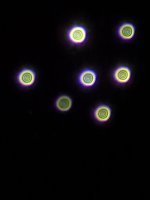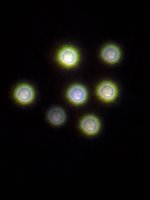Tbirds2222
New member

Many thanks to Henry and everyone here for a very informative thread that helped me getting my first scope!
I found a good deal on the Monarch 82EDA and was excited to order it, but got not much more luck than that apparently. Pictures below are from the 2nd unit but its serial number is right next to the 1st one which looked visibly soft and low contrast at and near max magnification with the included eyepiece.
Getting good shots of the star test has proved quite difficult with no good seeing condition outside so far. Even indoor seems to me is full of air turbulence. Pictures below are the best I could get indoor after many tries. With no experience on star tests and having seen no definitive images of prefect samples of the Monarch, my only impression is this scope has some sort of SA. Please let me know how bad it is, as well as any other aberrations present.
Images were with the Baader Hyperion Zoom Mk IV which was fitted with just 2 ring adapters instead of 3. One is a 2" male to T2 male adapter. The other is a T2 to Nikon F mount adapter. Both are generic low cost items. The Baader Zoom gives much more pleasant view, but at max mag, images are still not quite contrasty or as sharp as at lower mag.
(BTW, Henry mentioned of uploading star test images of the Monarch in the Kowa thread, but they somehow have escaped me.)
Thanks,
T.
I found a good deal on the Monarch 82EDA and was excited to order it, but got not much more luck than that apparently. Pictures below are from the 2nd unit but its serial number is right next to the 1st one which looked visibly soft and low contrast at and near max magnification with the included eyepiece.
Getting good shots of the star test has proved quite difficult with no good seeing condition outside so far. Even indoor seems to me is full of air turbulence. Pictures below are the best I could get indoor after many tries. With no experience on star tests and having seen no definitive images of prefect samples of the Monarch, my only impression is this scope has some sort of SA. Please let me know how bad it is, as well as any other aberrations present.
Images were with the Baader Hyperion Zoom Mk IV which was fitted with just 2 ring adapters instead of 3. One is a 2" male to T2 male adapter. The other is a T2 to Nikon F mount adapter. Both are generic low cost items. The Baader Zoom gives much more pleasant view, but at max mag, images are still not quite contrasty or as sharp as at lower mag.
(BTW, Henry mentioned of uploading star test images of the Monarch in the Kowa thread, but they somehow have escaped me.)
Thanks,
T.






